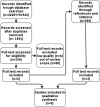Nonspecific complaints in the emergency department - a systematic review
- PMID: 31992333
- PMCID: PMC6986144
- DOI: 10.1186/s13049-020-0699-y
Nonspecific complaints in the emergency department - a systematic review
Abstract
Background: Nonspecific complaint (NSC) is a common presenting complaint in the emergency setting, especially in the elderly population. Individual studies have shown that it is associated with significant morbidity and mortality. This prognostic systematic review draws a synthesis of reported outcomes for patients presenting with NSC and compares them with outcomes for patients presenting with a specific complaint.
Methods: We conducted a literature search for publications, abstracts and conference presentations from Ovid, Scopus and Web of Science for the past 20 years. Studies were included which treated adult patients presenting to the Emergency Medical Services or Emergency Department with NSC. 2599 studies were screened for eligibility and quality was assessed using the SIGN assessment for bias tool. We excluded any low-quality studies, resulting in nine studies for quantitative analysis. We analysed the included studies for in-hospital mortality, triage category, emergency department length of stay, admission rate, hospital length of stay, intensive care admissions and re-visitation rate and compared outcomes to patients presenting with specific complaints (SC), where data were available. We grouped discharge diagnoses by ICD-10 category.
Results: We found that patients presenting with NSC were mostly older adults. Mortality for patients with NSC was significantly increased compared to patients presenting with SC [OR 2.50 (95% CI 1.40-4.47)]. They were triaged as urgent less often than SC patients [OR 2.12 (95% CI 1.08-4.16)]. Emergency department length of stay was increased in two out of three studies. Hospital length of stay was increased by 1-3 days. Admission rates were high in most studies, 55 to 84%, and increased in comparison to patients with SC [OR 3.86 (95% CI 1.76-8.47)]. These patients seemed to require more resources than patients with SC. The number for intensive care admissions did not seem to be increased. Data were insufficient to make conclusions regarding re-visitation rates. Discharge diagnoses were spread throughout the ICD-10 main chapters, infections being the most prevalent.
Conclusions: Patients with NSC have a high risk of mortality and their care in the Emergency Department requires more time and resources than for patients with SC. We suggest that NSC should be considered a major emergency presentation.
Keywords: Adult; Emergency department; Emergency services; Length of stay; Mortality; Nonspecific complaint.
Conflict of interest statement
The authors declare that they have no competing interests.
Figures
Comment in
-
How should nonspecific complaints be defined? Comment to: "nonspecific complaints (NSCs) in the emergency department".Scand J Trauma Resusc Emerg Med. 2020 Nov 11;28(1):110. doi: 10.1186/s13049-020-00805-x. Scand J Trauma Resusc Emerg Med. 2020. PMID: 33176834 Free PMC article. No abstract available.
References
-
- Wachelder Joyce J. H., Stassen Patricia M., Hubens Laura P. A. M., Brouns Steffie H. A., Lambooij Suze L. E., Dieleman Jeanne P., Haak Harm R. Elderly emergency patients presenting with non-specific complaints: Characteristics and outcomes. PLOS ONE. 2017;12(11):e0188954. doi: 10.1371/journal.pone.0188954. - DOI - PMC - PubMed
Publication types
MeSH terms
Grants and funding
LinkOut - more resources
Full Text Sources
Medical
Miscellaneous





